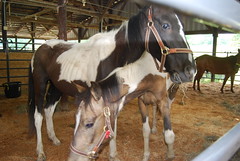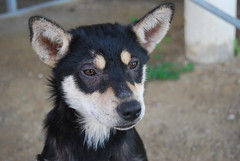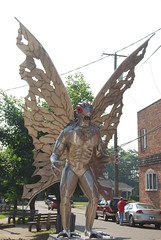Sunday was a day for the horses, mules and donkeys to settle into their new environment. The UAN volunteers took care of feeding and watering the equines as soon as they arrived and then began the task of building more partitions and rearranging the horses in their pens to better fit their needs. For the most part, all had settled in comfortably and it was relatively quiet, with the exception of Jack, the noisy, braying mule.
 The personalities of the animals are definitely starting to emerge: We have identified kickers, biters, bullies, fighters, pacifists, sweethearts, partners and food mongers, to name a few. We are able to see more of the health problems and injuries on the horses now that we have gotten closer to them and the UAN team has begun assisting the HSUS veterinary team in treating them.
The personalities of the animals are definitely starting to emerge: We have identified kickers, biters, bullies, fighters, pacifists, sweethearts, partners and food mongers, to name a few. We are able to see more of the health problems and injuries on the horses now that we have gotten closer to them and the UAN team has begun assisting the HSUS veterinary team in treating them.Though it was a hot and muggy day, the horses seemed to be quite comfortable and were enjoying having food and water readily available. All of us are looking forward to watching them blossom in their new temporary home.
We added a new member to our exclusive club -- another dog, this one picked up as he was wandering along the side of the road. Toward the end of the day volunteers Nova Keaton and Howard Edelstein spent some time pulling ticks off of him, giving the poor dog some much needed relief. Only time will tell who shows up next.
I have enjoyed getting to know the volunteers on this deployment and was interested to hear what drives each of them to go on these tough deployments, using vacation time to get away from work and paying their own way to get to the various locations, not to mention working long hours in less than ideal conditions.
What I heard over and over again is that they felt they needed to be advocates for animals who cannot speak for themselves and that they felt the need to make a difference on a larger scale than they could by volunteering at their local shelters or by donating money, even though they all do plenty of both. Though each UAN volunteer has a very different background, one thing they have in common is a passion for educating others on the value of animals, and sharing the UAN story is a great way to accomplish this.
So the dirt, grime, sweat, bugs and grueling work make it all worthwhile; in fact, it wouldn’t seem quite so worthwhile without the hardships. And it seems that in spite of the conditions, the volunteers all agree that they get much more out these rescues than they give.
Happy Memorial Day to all!
Photos: Joe Schuabuer of Cincinnati, Ohio and Ali; Betty Harmon of Angier, North Carolina can't resist Clifford the Big Red Mule; Howard Edelstein of Silver Spring, Maryland enjoys time with Crash, a dog he rescued on the side of the road; Nova Keaton of Oak Harbor, Ohio gets Clifford the Big Red Mule to take some hay. All photos courtesy of EARS volunteer Debbie Ferguson.




























